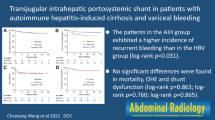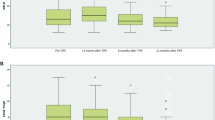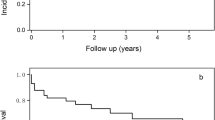Abstract
Purpose
To determine the frequency and predictive factors for alcohol recidivism following transjugular intrahepatic portosystemic shunts (TIPS) placed in patients with alcoholic cirrhosis.
Methods
One hundred ninety-nine patients who had a TIPS placed at a single institution for different indications in the setting of alcoholic cirrhosis were reviewed. Length of sobriety prior to TIPS placement and maintained sobriety at 1, 3 and 6–12 months after TIPS placement were recorded. Smoking history, substance abuse and psychiatric comorbidities were also recorded as was ascitic response to TIPS at 1, 3 and 6–12 months.
Results
At 1 month 11/199 (5.5%) patients had experienced a relapse while, 20/199 (10.1%) had at 3 months, and 44/199 (22.1%) had at 12 months. There was no difference in ascitic response in those who did and did not relapse at 1 month (p = 0.57), 3 months (p = 1.00) or 1 year (p = 0.44). The mean time of sobriety at the time of TIPS placement for those who relapsed by 12 months was significantly less than those who did not relapse (5.11 (1.10–7.90) months vs 18.32 (8.63–48.12) months, p < 0.001). Concurrent psychiatric comorbidity (p < 0.001), substance abuse (p < 0.001), age less than 40 (p = 0.004) and smoking history at the time of procedure (p < 0.001) were also associated with alcohol relapse.
Conclusion
Recidivism is a frequent issue for patients following TIPS placement; those who have concurrent psychiatric comorbidity, substance abuse, smoking history are younger than 40 and shorter sobriety duration prior to TIPS may be at increased risk.


Similar content being viewed by others
Abbreviations
- ALD:
-
Alcohol-related liver disease
- BMI:
-
Body mass index
- CPS:
-
Child–Pugh score
- LT:
-
Liver transplantation
- MELD:
-
Model for End-Stage Liver Disease
- MELD-Na:
-
Model for End-stage Liver Disease-Sodium
- PSG:
-
Post-procedural portosystemic gradient
- TIPS:
-
Transjugular intrahepatic portosystemic shunts
References
Rehm J, Samokhvalov AV. Shield KD global burden of alcoholic liver diseases. J Hepatol. 2013;59:160–8.
Mellinger JL, Shedden K, Winder GS, et al. The high burden of alcoholic cirrhosis in privately insured persons in the United States. Hepatology. 2018;68:872–82.
Kwong A, Kim WR, Lake JR, et al. OPTN/SRTR 2018 annual data report: liver. Am J Transplant. 2020;20:193–299.
Lucey MR, Connor JT, Boyer TD, Henderson JM, Rikkers LF. DIVERT study group. Alcohol consumption by cirrhotic subjects: patterns of use and effects on liver function. Am J Gastroenterol. 2008;103:1698–706.
Xie Y-D, Feng B, Gao Y, et al. Effect of abstinence from alcohol on survival of patients with alcoholic cirrhosis: a systematic review and meta-analysis. Hepatol Res. 2014;44:436–49.
Salerno F, Guevara M, Bernardi M, et al. Refractory ascites: pathogenesis, definition and therapy of a severe complication in patients with cirrhosis. Liver Int. 2010;30:937–47.
Garcia-Tsao G, Abraldes JG, Berzigotti A, et al. Portal hypertensive bleeding in cirrhosis: risk stratification, diagnosis, and management: 2016 practice guidance by the American Association for the study of liver diseases. Hepatology. 2017;65:310–35.
Planas R, Montoliu S, Balleste B, et al. Natural history of patients hospitalized for management of cirrhotic ascites. Clin Gastroenterol Hepatol. 2006;4:1385–94.
Rössle M, Gerbes AL. TIPS for the treatment of refractory ascites, hepatorenal syndrome and hepatic hydrothorax: a critical update. Gut. 2010;59:988–1000.
Piecha F, Radunski UK, Ozga AK. Ascites control by TIPS is more successful in patients with a lower paracentesis frequency and is associated with improved survival. J hep Reports. 2019;1:90–8.
Bai M, Qi XS, Yang ZP, et al. TIPS improves liver transplantation-free survival in cirrhotic patients with refractory ascites: an updated meta-analysis. World J Gastroenterol. 2014;20:2704.
Lim J, Curry MP, Sundaram V. Risk factors and outcomes associated with alcohol relapse after liver transplantation. World J Hepatol. 2017;9:771–80.
Young S, Bermudez J, Zhang L, et al. Transjugular intrahepatic portosystemic shunt (TIPS) placement: a comparison of outcomes between patients with hepatic hydrothorax and patients with refractory ascites. Diagn Interv Imaging. 2019;100:303–8.
Young S, Scanlon P, Sherestha P, et al. Duplex Ultrasound versus clinical surveillance in the prediction of TIPS malfunction placed for refractory ascites: is ultrasound surveillance useful? Cardiovasc Intervent Radiol. 2017;40:1861–5.
Zhou WC, Zhang QB, Qiao L. Pathogenesis of liver cirrhosis. World J Gastroenterol. 2014;20:7312.
Arroyo V, Colmenero J. Ascites and hepatorenal syndrome in cirrhosis: pathophysiological basis of therapy and current management. J Hepatol. 2003;38:69–89.
Fidelman N, Kwan SW, LaBerge JM, et al. The transjugular intrahepatic portosystemic shunt: an update. AJR Am J Roentgenol. 2012;199:746–55.
Kodali S, Kaif M, Tariq R, et al. Alcohol relapse after liver transplantation for alcoholic cirrhosis—impact on liver graft and patient survival: a meta-analysis. Alcohol Alcohol. 2018;53:166–72.
Kim WR, Lake JR, Smith JM, et al. OPTN/SRTR 2013 annual data report: liver. Am J Transplant. 2015;15:1–28.
European Association for the Study of Liver. EASL clinical practical guidelines: management of alcoholic liver disease. J Hepatol. 2012;57:399–420.
Rustad JK, Stern TA, Prabhakar M, et al. Risk factors for alcohol relapse following orthotopic liver transplantation: a systematic review. Psychosomatics. 2015; 56:21-35.
Kitajima T, Nagai S, Segal A, et al. Post-transplant complications predict alcohol relapse in liver transplant recipients. Liver Transpl. 2020;26:379–89.
Singal AK, Chaha KS, Rasheed K, et al. Liver transplantation in alcoholic liver disease current status and controversies. World J Gastroenterol. 2013;19:5953.
Moos RH, Moos BS. Rates and predictors of relapse after natural and treated remission from alcohol use disorders. Addiction. 2006;101:212–22.
Vaillant GE, Schnurr PP, Baron JA, et al. A prospective study of the effects of cigarette smoking and alcohol abuse on mortality. J Gen Intern Med. 1991;6:299–304.
McCallum S, Masterton G. Liver transplantation for alcoholic liver disease: a systematic review of psychosocial selection criteria. Alcohol Alcohol. 2006;41:358–63.
DiMartini A, Day N, Dew MA, et al. Alcohol use following liver transplantation: a comparison of follow-up methods. Psychosomatics. 2001;42:55–62.
Yang P, Tao R, He C, et al. The risk factors of the alcohol use disorders—through review of its comorbidities. Front Neurosci. 2018;12:303.
Kurti AN, Keith DR, Noble A, et al. Characterizing the intersection of Co-occurring risk factors for illicit drug abuse and dependence in a US nationally representative sample. Prev Med. 2016;92:118–25.
Funding
This research did not receive any specific grant from funding agencies in the public, commercial or not-for-profit sectors.
Author information
Authors and Affiliations
Corresponding author
Ethics declarations
Conflict of interest
The authors declare that they have no conflict of interest.
Consent for Publication
Consent for publication was obtained for the person’s data included in the study.
Ethical Approval
All procedures performed in studies involving human participants were in accordance with the ethical standards of the institutional and/or national research committee and with the 1964 Helsinki Declaration and its later amendments or comparable ethical standards.
Informed Consent
This study has obtained IRB approval from the University of Minnesota, and the need for informed consent was waived.
Additional information
Publisher's Note
Springer Nature remains neutral with regard to jurisdictional claims in published maps and institutional affiliations.
Rights and permissions
About this article
Cite this article
Cam, I., Gencturk, M., Lim, N. et al. Alcohol Recidivism Following Transjugular Intrahepatic Portosystemic Shunt Placement: Frequency and Predictive Factors. Cardiovasc Intervent Radiol 44, 758–765 (2021). https://doi.org/10.1007/s00270-020-02754-5
Received:
Accepted:
Published:
Issue Date:
DOI: https://doi.org/10.1007/s00270-020-02754-5




